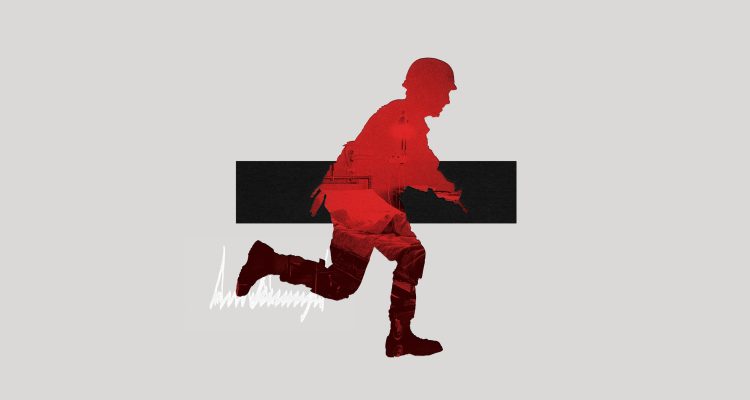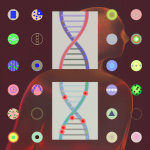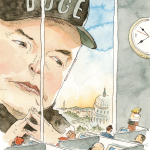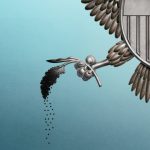The discovery began, as many breakthroughs do, with an observation that didn’t quite make sense. In 1948, two French researchers, Paul Mandel and Pierre Métais, published a little-noticed paper in a scientific journal. Working in a laboratory in Strasbourg, they had been cataloguing the chemical contents of blood plasma—that river of life teeming with proteins, sugars, waste, nutrients, and cellular debris. Amid this familiar inventory, they’d spotted an unexpected presence: fragments of DNA drifting freely.
The finding defied biological orthodoxy. DNA was thought to remain locked inside the nuclei of cells, and not float around on its own. Stranger still, these weren’t whole genomes but broken pieces—genetic flotsam cast adrift from an unknown source.
Mandel and Métais weren’t sure what to make of it. The scientific community, equally perplexed, largely ignored the paper for more than a decade. But biological mysteries rarely remain buried. Eventually, researchers returned to the question with a simple explanation. Each day, as billions of cells perish, they rupture, spilling their contents—DNA included—into the bloodstream. These fragments circulate briefly before being metabolized or cleared by the kidneys. This “cell-free DNA,” the researchers concluded, was the residue of the body’s ongoing cycle of death and renewal.
DNA seemed to be cast off from dying cells like debris from sinking vessels. What appears as waste may serve as witness—a sock, a spoon, a necklace drifting from a submerged compartment, each hinting at a life once lived. Might these fragments in our blood carry messages from the cells that released them? Could scientists assemble these molecular scraps and reconstruct the identities of the cells they came from?
In the nineteen-sixties, Aaron Bendich, a cancer researcher in New York, proposed that tumor cells, like healthy ones, might shed DNA into the bloodstream. By 1989—four decades after Mandel and Métais’s discovery—researchers had found concrete evidence of tumor-derived cell-free DNA in cancer patients’ blood.
The implications were far-reaching. For generations, scientists had searched for ways to detect cancer early: mammograms, colonoscopies, Pap smears—all designed to catch malignancies before they spread. The idea that cancer cells might be leaking their secrets into the blood suggested a radical new possibility: that we might detect malignancy not through imaging or a physical exam but by a simple blood draw. Scientists would eventually call this a “liquid biopsy,” and, for many, it augured a transformative leap in cancer screening.
The promise of early detection—of catching cancer before it announces itself through symptoms—continues to drive research and investment in the field. But this hope may hide a more complex reality.
“If we are to beat cancer, early detection and diagnosis are arguably the most effective means we have at our disposal,” a group from Cancer Research UK declared in a 2020commentaryinTheLancet Oncology. The case for cancer screening assumes the shape of a simple narrative: a lump forms in a woman’s breast; a mammogram detects it; a biopsy confirms malignancy; a surgeon removes it before it spreads. Her life is saved.
But now imagine two women visiting a mammography clinic. Both are found to have identical-looking lumps. Both are diagnosed with early breast cancer and scheduled for surgery. Each returns home relieved, convinced that modern medicine has intervened in time. As one woman told me, recalling such a moment, “Once I knew it was inside me, I wanted it out as soon as possible. I called the surgeon’s office every hour until they gave me an appointment the next week.”
The trouble is that amammogramreveals only the shadow of a tumor—it cannot divine the tumor’s nature. It shows the body of the cancer, not its mind: that is, a mammogram cannot tell us whether the tumor is aggressive, whether it has already spread or will remain inert. The image holds no clues to intention, to future propensities.
Suppose the first woman undergoes surgery, reassured by the idea of “early” detection, but it turns out that the cancer has sent metastatic cells beyond the reach of the scalpel. The procedure, though exacting, offers no benefit. She has endured harm without gain, the very opposite of the old medical injunction: First,do no harm.
The second woman faces the inverse. Her tumor appears ominous but is, by nature, indolent—slow-growing, noninvasive, never destined to threaten her life. Yet she, too, undergoes surgery, anesthesia, recovery. The procedure removes a tumor that posed no danger. Again: harm without benefit.
This paradox reveals a central flaw in our current model of cancer screening. We have become adept at locating cancer’s physical presence—its corporeal form—but remain largely blind to its character, its behavior, its future. We employ genomic assays and histopathological grading, but many early-stage tumors remain biologically ambiguous. They might be the kind of early cancers that surgery can cure. They might be slow-growing and unlikely to cause harm. Or, most concerning, they might already have metastasized, rendering local intervention moot. Three possibilities—yet we often cannot tell which we’re confronting.
To complicate matters further, false positives abound: tests that suggest cancer where none exists, leading to unnecessary procedures, anxiety, and harm. To begin navigating this treacherous terrain, we might turn to a curious figure—an Enlightenment-era clergyman and mathematician whose ideas now guide us through the darkness.
Thomas Bayes was no physician. Born at the start of the eighteenth century, he was a Presbyterian minister with a side gig in formal logic—an interpreter of uncertainty in an age that craved certainty. In the one portrait traditionally said to depict Bayes (though the sitter may have been misidentified), he appears as a sizable, self-assured man with a Wall Street haircut: Alec Baldwin in a clergyman’s coat. Bayes published only two papers in his lifetime: one a defense of God’s benevolence, the other a defense of Newton’s calculus. His lasting contribution came posthumously, in a Royal Society paper on conditional probability. Its argument still informs the way we assess information.
Imagine a group of a thousand heavy smokers in their sixties. One of them has lung cancer. That one-in-a-thousand chance is what Bayesians call the “prior probability”—the odds of having the disease before we know anything else. Now suppose we use a test that correctly detects lung cancer ninety-nine per cent of the time when it’s present. That’s the test’s “sensitivity.” It also correctly gives a negative result ninety-nine per cent of the time when cancer isn’t present—that’s the test’s “specificity.”
So what does it signify if someone in the group tests positive—what are the chances the person actually has cancer? Bayesian arithmetic gives a surprising answer: the test can be expected to identify the one person who actually has cancer, but it will also wrongly flag about ten people who don’t. That means there will be roughly eleven positive results, but only one of them is accurate. The chance that someone who tests positive has cancer, then, is just over nine per cent. In other words, eleven people would be sent for follow-up procedures, such as biopsies. And ten of them would go through a risky and invasive process—which can involve a punctured lung, bleeding, or other complications—with no benefit.
In short, if you set out to find a needle in a haystack, even with the best detector, you’ll mostly turn up hay. Choose a haystack with thousands of needles scattered among the bales, and you’ll start finding more needles than hay. Posterior probability (the chance that you’ve found a needle) depends on prior probability (how many needles were there to begin with).
Knowledge, in the Bayesian model, is always provisional, a process of updating one’s beliefs in light of new evidence. In a fifty-eight-year-old survivor of breast cancer with a strong family history of the disease, a new lump near the original site likely signals recurrence—intervention is warranted. In a twenty-year-old with no relevant history, the same finding is likely benign—watchful waiting may suffice.
The consequences of ignoring these principles are staggering. In 2021, according to one estimate, the United States spent more than forty billion dollars on cancer screening. On average, a year’s worth of screenings yields nine million positive results—of which 8.8 million are false. Millions endure follow-up scans, biopsies, and anxiety so that just over two hundred thousand true positives can be found, of which an even smaller fraction can be cured by local treatment, like excision. The rest is noise mistaken for signal, harm mistaken for help.
The quandaries of early detection don’t end there. I sometimes pose a question to my interns during morning rounds: “How do we judge whether a cancer-screening test is effective?” An answer usually comes quickly: “If the test detects malignancies at a high rate or at an early stage.”
But, as the mammography story illustrates, merely finding a tumor tells us nothing about what it will do. So I press further. Their next answer also comes quickly: “By dividing a population into screened and unscreened groups, then measuring which group lives longer without cancer.” But this approach invites another fallacy.
Suppose two identical twins develop breast cancer at the same time, in 2025. One undergoes regular screening; her tumor is caught early. She begins treatment—surgery, chemotherapy. The process is gruelling: a blood clot after surgery, an infection during chemo, months of recovery. Four years pass. She endures it all, hopeful for a cure.
Her sister, shaken by an old friend’s treatment ordeal, avoids screening altogether. She moves to upstate New York, tends apple trees, reads books, and shuns medical intervention. By 2029, breast-cancer symptoms appear, but she declines treatment.
In 2030, the first sister learns that her cancer has returned. She’s admitted to a hospital in New York City. That same month, her sister—now visibly ill—is admitted to the same facility. They lie in adjacent beds, reflecting on their choices. They die the same week.
Now comes the illusion. The first twin’s post-diagnosis survival is recorded as five years; the second’s, just one year. Doctors reviewing their cases might conclude that screening extended survival fivefold. But both women were born and died at the same time. The screening had no impact on life span. The apparent benefit is a statistical mirage—an artifact of when we start the clock. This is “lead-time bias,” which inflates survival time without improving outcomes.
Lead-time bias isn’t the only illusion that distorts cancer-screening results. Consider a village where a cancer occurs in two forms—one fast and fatal, the other slow and largely harmless. With annual screening, the slow-growing tumors are more likely to be flagged: they linger longer in a detectable, symptom-free phase. The aggressive ones, by contrast, often produce symptoms between screenings and are diagnosed clinically. (Patients with them can even die between annual tests.) After a decade, the data look promising: more early cancers found, longer survival after diagnosis. But the apparent benefit is misleading. Screening disproportionately detects indolent tumors—those less likely to be lethal in the first place. That’s known as length-time bias.
These twin illusions—lead-time bias and length-time bias—cast a flattering light on screening efforts. One stretches our measurement of survival by shifting the starting line; the other claims success by favoring tumors already predisposed to be less harmful. Together, they have misled cancer researchers for decades.
To determine whether a screening truly works, we have to measure not survival time but mortality. Did fewer people die of cancer in the screened group? This is the outcome that really matters. Yet demonstrating such a benefit is slow, arduous work. As a trialist, you must wait for the final end point: death. That can take decades. And you need a vast number of patients to capture any difference between the screened and unscreened cohorts. The process is relentless—screen, test, treat, repeat, and wait. Rigorous cancer-screening trials are expensive, time-consuming, methodologically thorny, and maddeningly uncertain. They test not only the validity of our methods but the stamina of our convictions.
The point isn’t that screening can’t pay off. The success stories are real. In 2022,The New England Journal of Medicinepublished theresultsof a landmark colonoscopy trial involving 84,585 participants in Poland, Norway, and Sweden. After more than a decade, the data showed an estimated fifty-per-cent reduction in deaths associated with colorectal cancer among those who received colonoscopies. Every four to five hundred colonoscopies prevented a case of colorectal cancer. The benefit was real—but demonstrating it required years of painstaking research.
The effectiveness of screening varies dramatically by cancer type. Consider ovarian cancer, a disease that often remains hidden until it has scattered itself across the abdomen. In 1993, researchers launched a major trial to test whether annual ultrasounds and blood tests could lower mortality. The scale was extraordinary: more than seventy-eight thousand women enrolled, half randomly assigned to screening. For four years, they endured transvaginal ultrasounds; for six years, routine blood draws. Then came more than a decade of monitoring. It was a collective act of generosity—tens of thousands submitting themselves to discomfort and uncertainty in the hope of sparing future patients.
One of them was a woman I knew, Sherry. She was a sharp, funny, full-tilt presence, the kind of person who would light up a room without trying. A bighearted executive with a mile-a-minute mind, she’d dive into a new project or a friend’s crisis with the same restless energy. When she got her negative result, she was relieved. But she kept showing up. Year after year, she endured the awkward ultrasounds, the blood draws, the odd waiting-room silences. She believed in the trial’s promise.
And what did we learn? Among the screened, 3,285 received false positives. More than a thousand underwent unnecessary surgeries. A hundred and sixty-three suffered serious complications—bleeding, infection, bowel injury. But after eighteen years there was no difference in mortality. Even with three to six additional years of follow-up, the results held.
We speak often of a “war on cancer.” But we rarely acknowledge the casualties of our efforts. This was a war story, too—a battle without a victory. Its legacy helps to explain why effective screening remains so elusive, and why the promise of cell-free DNA, of so-called liquid biopsies, is so alluring. What if cancer could be caught not through imaging or invasive exams but through its molecular contrails in the blood? What if we could not only detect a cancer’s presence but divine its intent? Perhaps we could finally build a test that saves lives without wounding so many in the process.
In 2016, a startup named Grail set out to do just that. The name itself—alluding to the holy grail of cancer detection—revealed both the company’s aspirations and the reverence with which it approached the challenge. Backed by a luminous scientific advisory board and headquartered in Menlo Park, California, Grail began developing what it termed a “multi-cancer early detection” test, based on the analysis of cell-free DNA.
The approach was ingenious: extract fragments of DNA circulating in the bloodstream—the same shards first glimpsed by Mandel and Métais nearly seven decades earlier—and sequence them to identify abnormalities in the regulation of gene expression that are indicative of cancer. Machine-learning algorithms, attuned to chemical modifications in the DNA, would detect what Grail called the “cancer signal,” and then decode its origin, determining where in the body it might have begun. This was painstaking, rigorous work.
I asked Joshua Ofman, Grail’s president, about the company’s ambitious goals. Currently, he noted, guidelines typically recommend screening for only five cancers: breast, cervical, prostate (though the value of the test is disputed), colorectal, and, in smokers, lung. “This one-cancer-at-a-time approach detects just fourteen per cent of incident cancers in the U.S.—a dismal number,” he told me. “The status quo is unacceptable. We don’t get to choose which cancer we get, and looking for one cancer at a time isn’t addressing over eighty per cent of cancer deaths. Adding more single-cancer screening tests isn’t viable, as each carries a high false-positive rate that would collectively overwhelm the health-care system.”
Grail’s test, though, has identified more than fifty types of cancer. Between August, 2016, and February, 2019, Grail launched what would become a landmark study to assess how well the test—later named the Galleri test—performed. The scale was impressive: more than fifteen thousand participants enrolled at more than a hundred and forty sites, including élite medical centers in the United States. The study was carefully structured into sub-studies, each aimed at answering a specific question about the test’s performance. After five years of data collection and analysis, all the results were out by 2021.
At first glance, the paper read like a scientific tour de force—an elegant fusion of medicine, mathematics, biochemistry, computational biology, and machine learning. I remember poring over it one muggy evening in 2021, as theCOVIDpandemic raged. Armed with an urn of coffee, I sifted through fifty dense pages of tables and text, reading late into the night.
Sub-study 3 stood out: of 4,077 participants, there were 2,823 with known cancer, and 1,254 confirmed to be cancer-free. Grail’s test identified malignancy in 1,453 of the cancer cases, missing it in 1,370. The over-all sensitivity—its ability to detect cancer when it was truly present—stood at 51.5 per cent. For a single blood draw across dozens of cancer types, it was an astonishing result. Few existing methods came close. Most striking was the test’s ability to detect malignancies long considered unscreenable—pancreatic, ovarian, and others that had eluded surveillance. Meanwhile, just six of the 1,254 cancer-free participants received false positives—a remarkably low rate of about half a per cent.
The company’s rhetoric was upbeat, and not without cause. Researchers sounded confident. Investors were jubilant. Patients were hopeful. At last, it seemed, we had a liquid biopsy worthy of the name: a test that could detect multiple cancers from a single vial of blood.
Deeper in the data, though, a sobering number surfaced. The test’s sensitivity for Stage I disease—the benchmark for any screening tool—was just above sixteen per cent. Shouldn’t early detection be the point? Yet early cancers—still local, still operable—often slipped past, shedding too little signal to be heard. The test performed better as cancers advanced, which made sense: advanced tumors shed more DNA. But they are also less responsive to treatment.
The picture varied widely by cancer type. For Stage I pancreatic and ovarian cancers, sensitivity reached fifty and sixty per cent, respectively—genuinely encouraging numbers for two of the most elusive malignancies. For early esophageal and lung cancers, sensitivity dropped to twelve and twenty-one per cent—levels that would severely limit clinical utility.
Even so, the detection of certain early-stage cancers—especially ovarian and pancreatic—was exciting. Early-stage cancers offer more options, more time, and more hope. They are more likely to be curable. The economic and human calculus shifts, too: early cancers cost much less to treat than advanced ones. Surgeries are less extensive; chemotherapy, less punishing. Patients retain more energy, more dignity, more of their ordinary lives.
By the time I finished reading, I was cautiously optimistic. One critical metric for any screening test is its positive predictive value, or P.P.V.—the likelihood that a positive result truly signals disease. For Grail’s test, the over-all P.P.V. stood at roughly forty-five per cent. If you tested positive, that is, your odds of actually having cancer were slightly less than fifty-fifty. Many existing screening tests operate with worse predictive values, often producing more unnecessary interventions than Grail’s approach seemed likely to trigger.
In 2021, after presenting some additional results, Grail began introducing the Galleri test to the public. Before long, Grail’s website featured the story of Rich, a gym owner, perhaps seventysomething, with an avuncular, steadying presence. In a sleekly produced video, Rich recounts how the test detected a cancer signal in his blood. He visited an oncologist and learned that the test had uncovered cancer that had already spread to his lymph nodes. “I felt relief—relief that we caught this early,” he says, his hand resting on his chest. “Even though it’s Stage III, I wouldn’t know about it for another six months to a year, and then it would be too late.”
It’s a moving story. But, as I watched, I couldn’t shake the dissonance between the narrative and the clinical reality. This wasn’t early detection in the traditional sense—a small tumor caught before it could spread. Rich’s cancer had already breached the lymphatic system. If this was a victory for screening, it felt like a qualified one—less a triumph than a brief reprieve.
Two years ago, Grail published theresultsof another study, inThe Lancet. It offered a more textured portrait of the test’s capabilities. From late 2019 through 2020, researchers enrolled more than sixty-six hundred participants, drawing blood from each and submitting those samples to molecular scrutiny. The study was not randomized; it was designed to mimic how the test might perform in everyday medical practice.
As in earlier trials, technicians extracted and sequenced fragments of cell-free DNA from plasma. Machine-learning algorithms sifted through the cellular din for whispered signals. Signals emerged in ninety-two participants—each one, in theory, a life saved or prolonged.
Follow-up testing—scans, biopsies, the full diagnostic arsenal—confirmed thirty-six cases of cancer. Of these, twenty-nine were newly diagnosed cancers; seven were recurrences of previously treated disease. What stirred real hope was that fourteen of the newly diagnosed cancers—roughly half—were in an early stage (Stage I or II) and potentially curable. And the test had identified malignancies for which no standard screening exists: cancers of the small intestine, the pancreas, and a rare spindle-cell neoplasm, a form of bone cancer—all detected at a stage when surgical removal was still possible. These are cancers that typically announce themselves only after spreading widely.
In an accompanyingLancetcommentary, however, the physician Richard Lee and the epidemiologist Hilary Robbins called the test’s over-all sensitivity “somewhat underwhelming.” A comparable number of cancers, they pointed out, had been found through conventional methods. The Galleri test, they concluded, “will probably not replace standard screening,” and theyurged caution, calling for its cost-effectiveness to be analyzed before it was added to existing protocols.
They also flagged a crucial detail: of the fourteen early-stage cancers, only six were newly diagnosed solid tumors—malignancies that could potentially be removed with curative surgery. The remaining eight were liquid tumors—leukemias and myelomas, diffuse diseases not easily contained or “cut out.” As the editorialists noted, “This finding raises important questions regarding the test’s ability to reduce cancer mortality at the population level.”
Even with its limitations, though, Grail had cleared a meaningful hurdle, in that the test had identified cancers in seemingly healthy individuals which might otherwise have gone undetected. But pressing questions remained. Would that early liver tumor—or that pancreatic lesion—have proved fatal without intervention? If such cancers had been regularly caught this early before, their natural histories might be charted. Might some have stayed dormant, even regressed? Or were they all destined to spread?
There was only one way to know. Grail would need to show a reduction in cancer-specific mortality in a properly randomized trial—the elusive gold standard that has undone so many promising screening technologies.
The challenge was immense, requiring the enrollment of large numbers of participants to be followed for many years. In a fragmented health-care system like that of the United States, such studies are also commercially treacherous: investors recoil from timelines this long and outcomes this uncertain. And yet no shortcut currently exists.
Grail was already conducting a study in partnership with the U.K. National Health Service’s English system. The study, announced in late 2020, was vast: more than a hundred and forty thousand participants, enrolled across eleven mobile clinics at a hundred and fifty-one locations throughout England. “The trial was designed with three consecutive years of screening in order to achieve the primary endpoint, which is the absolute reduction in the number of late-stage (Stage III and IV) cancer diagnoses,” Harpal Kumar, who runs Grail’s international operations, wrote. A review of the data from the first round of screening was scheduled for 2024, with final results expected in 2026. If early data proved promising, the Galleri test would advance into a larger pilot program within N.H.S. England.
The partnership stirred immediate controversy among cancer epidemiologists. The N.H.S. occupies a singular place in British life—both a cherished institution and a perennial target of criticism. The idea of a private American company embedding itself in the fabric of the public-health system raised alarm. In a sharply wordedLancetcommentary titled “Grail-Galleri: Why the Special Treatment?,” eight prominent physicians, epidemiologists, and sociologistsissued a blunt warning: “A cancer screening programme that offers no improvement in cause-specific mortality (or quality of life) is only doing harm and wasting money.” In their view, “TheGRAIL-Galleri trial must, as a minimum, show direct benefit in reducing cancer-specific mortality.” No surrogate end point would suffice. They were troubled that the N.H.S. trial had chosen “stage shift”—a reduction in late-stage diagnoses—as its primary metric. The ovarian-cancer-screening debacle that started in the nineties had made it clear that more early diagnoses do not necessarily mean fewer deaths. “Although commercial interests are powerful,” the critics cautioned, “the NHS can ill-afford to be a world leader in the adoption of poorly evaluated interventions that might be of little or no benefit, harm people, and waste resources that could be better used elsewhere.”
In the spring of 2024, I sat at my desk awaiting the N.H.S. announcement about the Galleri’s performance. If the early data were exceptionally positive, the Galleri test was expected to expand into a larger pilot. When the statement finally arrived, it was strikingly terse: “Based on data from the first year of the three-year NHS-Galleri trial, NHS England has decided that it will wait to see final results, expected in 2026, before considering whether an NHS rollout of the Galleri multi cancer early detection test (the Multi Cancer Blood Test Programme, MCBT) should go ahead.”
What did this mean? Had the test fallen short—or had the analysis simply been inconclusive? According to Grail’s own framework, “three robust, ambitious and pre-specified criteria” were to guide the decision: a reduction in late-stage-cancer diagnoses between screened and unscreened groups, the test’s positive predictive value, and the total cancer-detection rate in each cohort.
I contacted Joshua Ofman, Grail’s president. “The N.H.S. was looking for an early sign ofexceptionalbenefit from the first round of screening only, which has not been seen in previous screening trials for the first round of screening,” he told me. His basic message: too little data, too soon to tell. (Grail presumably had different expectations, though, when it agreed to allow the N.H.S. to review the early data.)
Seeking clarity, I reached out to Charles Swanton, the chief clinician at Cancer Research UK. His response was immediate: “As co-chief investigator, I am blinded to any data until the final results.” John Bell, a former Regius Professor of Medicine at Oxford and a global authority on genomic medicine, was no better informed. “No clue,” he replied. “I know as much as you do. Maybe ask Peter Johnson.”
Johnson—the national clinical director for cancer at N.H.S. England, and one of the field’s most respected clinical scholars—e-mailed back promptly, too. “The study has completed 3 years of blood sampling, and we are waiting to see the results of this as per the statistical analysis plan and the study protocol, before making further decisions. No analysis of the data has been made as yet.” He clarified that the May, 2024, statement was not a formal interim analysis that would determine the trial’s direction.
I followed up with a set of questions: Had Grail’s “three robust, ambitious and pre-specified criteria” been evaluated? If this wasn’t an interim analysis, what exactly had been assessed? Would promising data lead to a broader rollout funded by the N.H.S.? Why had Grail chosen stage shift, rather than cancer-specific mortality, as the primary end point? And would mortality be measured in a subsequent study?
Then came the key disclosure: “I can confirm that at least one of the three criteria was not met,” he wrote, explaining why the implementation pilot would not proceed in 2024. He acknowledged the glacial pace of cancer-screening research: “Cancer screening trials typically take 10-15 years to publish on mortality, and when positive it typically takes a further 10-15 years before a screening programme with high coverage is rolled out nationally. The approach we have taken to the NHS-Galleri trial and a possible implementation pilot sought to accelerate this process, without losing the methodologic rigour that is essential to the success of any such programme.”
Harpal Kumar chimed in on Grail’s website: “This early look at certain selected metrics provides only a limited view. As demonstrated in previous cancer screening trials, results from the first screening round do not always reflect the final results, especially for reduction in late stage diagnosis.”
In truth, some version of this story could be told about nearly every novel, high-tech cancer-screening test. The contours shift, the technologies evolve, but the core dilemmas remain: identifying which cancers will be of clinical significance, navigating illusions like lead-time and length-time bias, and, ultimately, proving not just that we can detect more cancers but that we can prevent more deaths.
It’s possible that the accelerating forces of cancer genetics and machine learning may yet transform the Bayesian landscape of early detection. For generations, we’ve watched malignancies thread through families—colorectal, ovarian, breast, pancreatic. The pattern is familiar, even if not fully understood. We’ve typically looked for single-gene mutations—BRCA1, BRCA2, MLH1—that signal elevated risk. But most inherited risk isn’t carried by one rogue gene. It emerges from the accumulation of many—a polyphony of small variations, each nudging risk ever so slightly higher. Today, advances in genome sequencing and computational modelling have begun to untangle this architecture. Sophisticated algorithms can scan entire genomes, mapping how thousands of tiny genetic variations interact. One such model, attuned to thousands of genetic loci, can already predict adult height. Nutrition still matters, but the precision of these forecasts represents a remarkable advance.
Similar models are now being trained to predict vulnerability to complex diseases—obesity, heart disease, and, increasingly, cancer. A woman with a family history of breast cancer can now receive a “polygenic risk score”—a composite of dozens or hundreds of gene variants. Soon, such models may be able to account for the role played by environmental exposures and chance—offering a more dynamic, individualized map of risk.
Imagine designing screening trials not for the general population but for people already flagged by genetics—those with high polygenic scores for breast or colon cancer. Add in other risk factors: age, prior diagnoses, exposures. In such a world, screening wouldn’t be universal. Those at high risk would receive focussed surveillance. Those at low risk might be spared unnecessary procedures. Preselecting high-risk individuals dramatically sharpens the predictive power of screening. A suspicious nodule on a CT scan or a positive result from a liquid biopsy would be more meaningful. More signal, less noise. The likelihood of benefit increases; the risk of harm recedes.
Inevitably, this new paradigm carries its own psychological burden. Bayesian risk begets Bayesian anxiety. Patients begin to navigate risk as a terrain—scores, thresholds, probabilities—calibrating and recalibrating their place within it. As one patient put it, “It’s like being under siege”—not by an actual illness but by a prospective one. This phenomenon has given rise to the telling neologism “previvor”—someone living in the long shadow of a disease they have not yet developed but to which they are genetically predisposed. Unlike survivors, who have endured illness and emerged changed, previvors find themselves suspended between health and its anticipated betrayal. Their lives are shaped not by diagnosis but by possibility. The borders of Cancerland—the oncologist David Scadden’s apt term—have expanded dramatically. Once reserved for those with active disease, the territory will soon include millions pulled into it by risk scores alone.
The argument between early-detection advocates and epidemiologic rigorists continues to sharpen. Proponents of emerging technologies—cell-free-DNA assays, novel biomarkers, whole-body imaging—argue that traditional standards set an impossibly high bar. Randomized trials powered to demonstrate reductions in cancer-specific mortality can take decades. Even Bayesian trials targeting high-risk groups face slow enrollment and long follow-up. These studies often conclude like weary medieval caravans, staggering home with hard-won goods—only to find the landscape changed. As Ofman warned, by the time the final results arrive the technology may already be obsolete. What if, after thirty years, a trial yields a modestly positive signal—just as a newer, better test emerges?
“All screening programmes do harm; some do good as well, and, of these, some do more good than harm at reasonable cost,” a team of epidemiologists wrote in 2008. The point still holds. But, once a screening test is widely adopted, it becomes almost impossible to unwind, even when its benefits prove marginal. The political fallout would be fierce. The psychological toll—undoing a sense of protection—would be immense.
Meanwhile, new technologies continue to flood in, each offering the seduction of speed. With them comes the temptation to accept looser surrogates for efficacy: earlier detection, shifts in stage, improved survival curves. The pressure to act is real. But so is the question of whether we can adapt our standards of evidence without compromising them—finding forms of rigor that move at the pace of innovation yet still tell us what we most need to know.
I think of Sherry. She had stayed in the ovarian-cancer trial for years after her negative result—showing up for every scan, every blood draw, believing in the work. She’d felt enormous relief, and she channelled that relief into something larger: fund-raising, advocacy, public support for biomedical research. Then, in 2020, she was diagnosed with metastatic ovarian cancer. Despite surgery and intensive chemotherapy, she died two years later. Would she still be alive had the original screening been more effective? No one can say. But the question lingers.
In 2021, during her final year, I came down with a bad cold. Sherry messengered a container of homemade chicken soup to my apartment. It was a small, characteristic act: practical, generous, unasked for. And it has stayed with me—more immediate than any p-value or hazard ratio. Whenever I return to the statistical puzzles of early detection, I think of her. The subjects of screening trials are not abstractions. They are human beings, with lives that touch others in ways no data point can capture.
Perhaps, in time, we’ll build tools that can not only detect cancer’s presence but predict its course—tests that listen not just for signals but for intent. Early work with cell-free DNA hints at this possibility: blood tests that may one day tell us not only where a cancer began but whether it’s likely to pose a threat to health. For now, we dwell in a liminal space between promise and proof. It’s a space where hope still outpaces certainty and the holy grail of perfect screening remains just out of reach. ♦
This is drawn from the updated fifteenth-anniversary edition of “The Emperor of All Maladies.”















